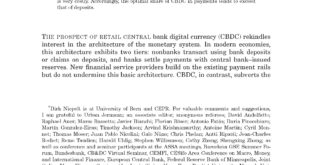With Cyril Monnet and Remo Taudien. University of Bern Discussion Paper 25.01, January 2025. PDF. The proposed revision of the Swiss Banking Act introduces a public liquidity backstop (PLB) for distressed systemically important banks (SIBs), in part to facilitate resolution. We examine the impact of the PLB on fiscal balances, societal welfare, and the incentives of bank shareholders and management. A PLB, like too-big-to-fail (TBTF) status, acts as a subsidy for non-convertible...
Read More »“Money and Banking with Reserves and CBDC,” JF, 2024
Journal of Finance. HTML (local copy). Abstract: We analyze the role of retail central bank digital currency (CBDC) and reserves when banks exert deposit market power and liquidity transformation entails externalities. Optimal monetary architecture minimizes the social costs of liquidity provision and optimal monetary policy follows modified Friedman rules. Interest rates on reserves and CBDC should differ. Calibrations robustly suggest that CBDC provides liquidity more efficiently than...
Read More »“Money and Banking with Reserves and CBDC,” CEPR, 2023
CEPR Discussion Paper 18444, September 2023. HTML (local copy). Abstract: We analyze the role of retail central bank digital currency (CBDC) and reserves when banks exert deposit market power and liquidity transformation entails externalities. Optimal monetary architecture minimizes the social costs of liquidity provision and optimal monetary policy follows modified Friedman (1969) rules. Interest rates on reserves and CBDC should differ. Calibrations robustly suggest that CBDC provides...
Read More »“Payments and Prices,” CEPR/SNB, 2023
CEPR Discussion Paper 18291 and SNB Working Paper 3/2023, July 2023. HTML, PDF (local copy CEPR, local copy SNB). We analyze the effect of structural change in the payment sector and of monetary policy on prices. Means of payment are obtained through portfolio choices and commodity sales and “liquified” through velocity choices. Interest rates, intermediation margins, and costs of payment instrument use affect portfolios, velocities, liquidity, relative prices, and the aggregate price...
Read More »“Digital Euro: An Assessment of the First Two Progress Reports,” SUERF, 2023
SUERF Policy Brief 612, June 2023. HTML, PDF. Executive summary: The ECB’s first two progress reports on the digital euro clarify the project teams’ considerations. Some motivations for a digital euro remain vague, some fundamental tradeoffs receive limited attention. Most importantly, the reports lack an analysis of why digital euro holdings as stores of value are not desirable and whether strategies to limit such holdings cause collateral damage. Against that backdrop some of the design...
Read More »“Digital Euro: An Assessment of the First Two Progress Reports,” European Parliament, 2023
European Parliament, April 2023. PDF. Executive summary: The two progress reports provide an insightful overview over some of the thinking underlying the digital euro project. The reports remain vague in some respects, which is not surprising given the early stage of the project and the division of tasks between the ECB and the Commission. The first report suggests that the digital euro can help preserve public money as the anchor of the payment system, but it does not explain how the...
Read More »The Economist on CBDC—and SVB
The Economist refers to our work in the `Free Exchange’ section: But some argue banks would work fine if the public switched their deposits for central-bank digital currencies, so long as the central bank stepped in to replace the lost funding. “The issuance of [such currencies] would simply render the central bank’s implicit lender-of-last-resort guarantee explicit,” wrote Markus Brunnermeier and Dirk Niepelt in 2019. This scenario seems to have partly materialised since the failure...
Read More »“Sovereign Bond Prices, Haircuts and Maturity,” JIE, 2023
With Tamon Asonuma and Romain Ranciere. Journal of International Economics 140, 103689, January 2023. PDF. We document that creditor losses (”haircuts”) during sovereign debt restructurings vary across debt maturity. In our novel dataset on instrument-specific haircuts suffered by private creditors in 1999-‒2020 we find larger losses on short- than long-term debt, independently of the specific haircut measure we use. A standard asset pricing model rationalizes our findings under two...
Read More »Contagion in Decentralized Markets
At the BIS 21st Annual Conference in June I discussed work by Alfred Lehar and Christine Parlour on “Systemic fragility in decentralised markets.” The paper and my discussion have now been issued as BIS working paper 1062.
Read More »“Sovereign Bond Prices, Haircuts and Maturity,” UniBe, 2022
With Tamon Asonuma and Romain Ranciere. UniBe Discussion Paper 22-13, November 2022. PDF. We document that creditor losses (”haircuts”) during sovereign debt restructurings vary across debt maturity. In our novel dataset on instrument-specific haircuts suffered by private creditors in 1999-‒2020 we find larger losses on short- than long-term debt, independently of the specific haircut measure we use. A standard asset pricing model rationalizes our findings under two assumptions, both...
Read More » Swiss Economicblogs.org
Swiss Economicblogs.org

